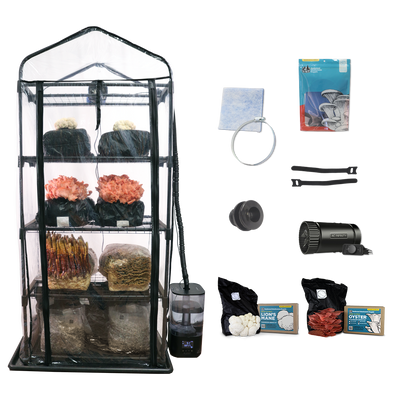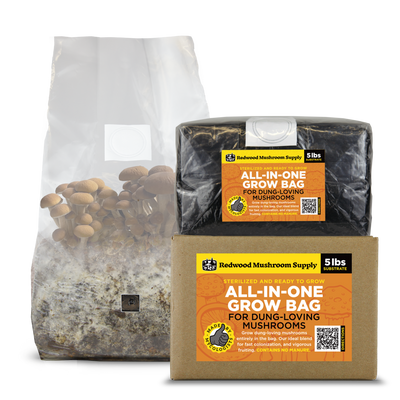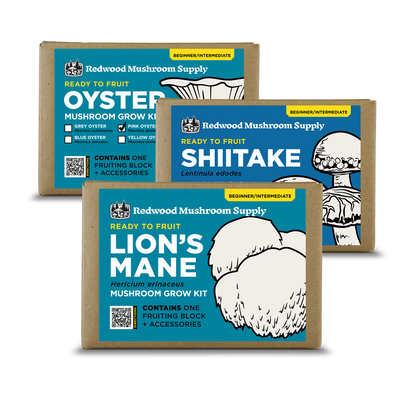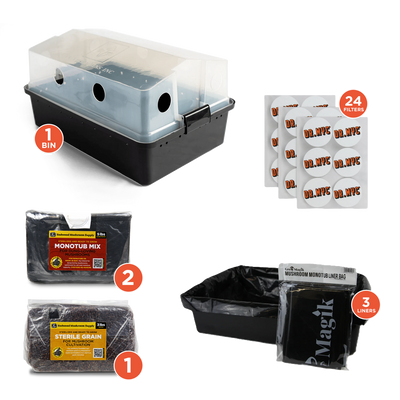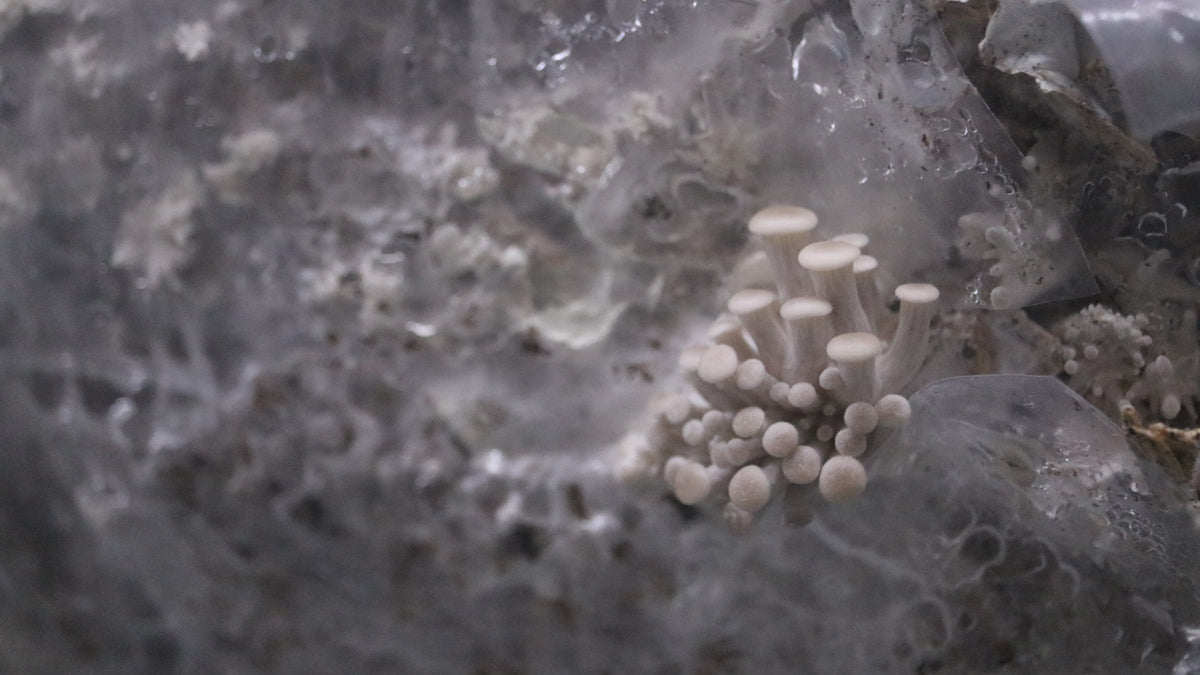While preparing substrates and inoculating them are the foundational steps of mushroom cultivation, fruiting is the climax that makes all your efforts worthwhile. It’s when the mushrooms you’ve been waiting for finally come to fruition and make their appearance.
Like every part of the cultivation process, fruiting has its own methodology and best practices. While it is relatively straightforward, it can be rather delicate, depending on your conditions. After all, in nature, mushrooms only appear when the conditions are right, something mushroom growers must learn to mimic if they want to be successful in their operation.
Preparing For Fruiting
Recognizing Full Colonization

The transition from incubation to fruiting is primarily marked by the complete colonization of the substrate. At this stage, your fungal mycelium has completely grown throughout the substrate and assimilated its nutrients. With little food left and a store of energy reserves, there's only one thing left for your fungus to do. Fruit!
Several signs indicate your mushroom block is fully colonized and ready to fruit.
-
Full Colonization: your substrate should be entirely intertwined by fungal mycelium. The original substrate should be unrecognizable as it becomes colonized by a dense mat of white mycelium.
-
Formation of Pins: Another sign that you are ready for fruiting is because your fungus starts producing pins or primordia. These are the tiny “baby” mushrooms that will grow into full size given adequate positions.
-
No Growth: Finally, if you’ve stopped seeing the growth of mycelium and you are past the estimated time frame of incubation (mentioned in the incubation article), it’s probably time to fruit.
- The Case For Shiitake: While we plan to have a whole text outlining Shiitake cultivation on substrates, it’s important to mention that Shitake has its unique stages that precede fruiting. Most importantly, for Shitake mushrooms, the outer surface of the mycelium turns completely brown.
Transitioning To Fruiting
Depending on how you are growing, there may be specific steps to take before placing your grow kits into their final fruiting conditions.
Cutting Grow Bags
If you are utilizing a grow bag, you must make an incision from which the mushrooms can grow. This also provides ample fresh air, which stimulates the formation of pins in this region.
The incision can simply be a single 3” slice or two in the shape of an X. Providing a single place for mushrooms to fruit results in more extensive and more robust clusters while making several small incisions will cause several small clusters. Typically, one in a central spot is sufficient for a 5 lb kit, while larger kits may require a couple.
Top Fruiting

In some cases, you may also want to top-fruit your grow bags. This entails opening your grow bag and letting your mushroom fruit from the top. You may cut the bag just an inch above the substrate or leave a larger lip for species that enjoy a high CO2 environment (like Enoki or King Oysters). While top-fruiting can produce robust fruiting bodies with an excellent structure, it doesn’t necessarily improve yields. Since part of the substrate is exposed, it is also more prone to drying. In some cases, like with antler reishi, you can fruit them in-bag.
Buckets and Containers
If you grow in buckets or rigid containers, fruiting bodies will naturally grow through gaps and quickly push through micropore tape.
Triggering Fruiting
While pins will often occur naturally, especially once placed in an environment with ample humidity and fresh air, other times, you may need to “trigger” their growth.
Cold Shock: Some species, like Shiitake and Enoki, require cold temperatures to start fruiting. This can be done by soaking them in cold water or placing them in the fridge. Another option is to put them in a cooler with ice or frozen water bottles. About 12-16 hours is typically recommended for a cold shock.
Soaking: Soaking your grow kit is a great way to provide additional moisture to your substrate and promote fruiting. You can do this simply by submerging your grow kit in water for about 12 hours.
Smacking: While not typically recommended, very stubborn grow kits that do not want to fruit can be triggered by smacking. Simply give your grow kit a single but adamant slap. Logs can be hit with a mallet after soaking.
Environmental Conditions for Fruiting
After you’ve prepped your grow kit for fruiting, you must place them in their ideal conditions and wait for your mushrooms to appear! Three main environmental conditions are essential to consider when fruiting. These are fresh air exchange (FAE), relative humidity (RH), and temperatures.
Temperature

Proper temperatures are mandatory for the healthy growth of your mushroom-fruiting bodies. Ideal fruiting temperatures are typically slightly lower than those utilized to promote quick growth during incubation.
While mushrooms tend to have a wide temperature range in which they can fruit, in most cases, higher quality mushrooms are produced on the lower end of this tolerance range. These tend to grow slower but are denser, sturdy, have a better texture, and may have a longer shelf-life.
Generally speaking, for most mushrooms, a temperature range of between 60-70°F is great for fruiting. Below is a table with more details on a per-species basis. These numbers can vary greatly depending on your strain.
| Mushroom | Ideal Fruiting Temperature (°F/°C) |
|---|---|
| Enoki (Flammulina velutipes) | 50-60°F (10-15°C) |
| Pioppino (Agrocybe aegerita) | 60-70°F (15-21°C) |
| Turkey Tail (Trametes versicolor) | 55-70°F (13-21°C) |
| Lion's Mane (Hericium erinaceus) | 55-75°F (13-24°C) |
| Shiitake (Lentinula edodes) | 55-70°F (13-21°C) |
| Maitake (Grifola frondosa) | 50-65°F (10-18°C) |
| Chestnut (Pholiota adiposa) | 55-65°F (13-18°C) |
| Italian Oyster (Pleurotus pulmonarius) | 55-70°F (13-21°C) |
| Nameko (Pholiota nameko) | 55-65°F (13-18°C) |
| White Oyster (Pleurotus ostreatus) | 55-70°F (13-21°C) |
| King Oyster (Pleurotus eryngii) | 50-65°F (10-18°C) |
| Blue Oyster (Pleurotus ostreatus var. columbinus) | 60-70°F (15-21°C) |
| Pink Oyster (Pleurotus djamor) | 70-80°F (21-27°C) |
| Golden Oyster (Pleurotus citrinopileatus) | 70-80°F (21-27°C) |
| Psilocybe cubensis | 70-80°F (21-27°C) |
| Reishi (Ganoderma lucidum) | 65-80°F (18-27°C) |
Relative Humidity (RH)

As we all know, mushrooms thrive in wet conditions when there is an abundance of ambient moisture. They are, after all, about 80-90% water! While some of this moisture can come from the growth substrate itself, a significant portion is also provided by the ambient air. High levels of ambient humidity promote pinning and healthy fruiting, while low levels tend to inhibit pinning and can dry out mushrooms, significantly impacting yield.
Relative Humidity is the technical term used to define how saturated the air is with moisture. For example, at 100% relative humidity, air cannot hold any more moisture, and it naturally begins condensing. RH has a strong relationship with temperature, as warmer air can hold more moisture than cooler air. This means that as temperatures go up, RH levels tend to decrease unless there is an additional source of moisture.
Ideal Relative Humidity For Fruiting Mushrooms
Generally speaking, all mushrooms require RH levels of about 80% to 95% to properly fruit.
- Higher RH levels (90-95%) are best at the beginning of the fruiting stage to promote the formation of pins.
- Lower (80-90%) RH levels are significant during the later part of fruiting to promote healthy growth.
- It is best to avoid levels of RH that are above 95%. These can cause abnormal fruiting or even cause bacterial disease in the mushroom. Generally speaking, you also want to avoid wetting the mushrooms directly or promoting condensation on their surface.
Monitoring and Controlling Humidity

Professional growers use humidifiers to increase RH content in their fruiting rooms. These can be automated to turn on when RH reaches low levels. Some growers add hydrogen peroxide or vinegar to their humidifier water to help control potential contaminants in the water.
If you do not have a fully equipped grow room, it is possible to promote high levels of RH via other means. Sometimes, simply placing your fruiting blocks in a naturally moist area like a basement, bathroom, or under a porch can be sufficient to promote healthy fruiting. Another option is to use grow tents, fruiting chambers, or Martha tents (discussed later), which will naturally retain moisture. Regular misting or wetting of the fruiting area (walls, floors, etc.) can also help increase ambient moisture levels.
As mentioned, many digital thermometers can also read ambient humidity levels. This can be a great way to monitor the RH and adjust as needed.
Fresh Air Exchange (FAE)
Fresh air exchange is a crucial and often overlooked environmental condition required during the fruiting stage. FAE represents the rate at which fresh air is introduced into the grow area.
FAE is important as it replenishes the air from the grow room, which tends to naturally accumulate CO2 and diminish in oxygen due to the fungus's metabolism. Like us, fungi breathe O2 and release CO2 during their growth. While providing plenty of fresh air is not necessary during incubation, it is fundamental to fruiting.
-
High FAE (which is low in CO2 and high in O2) stimulates the formation of pins and healthy fruiting.
- Low FAE can impede pinning and cause leggy or unhealthy mushrooms.
The Challenge of FAE
The challenge with FAE is that the natural environment doesn’t always provide fresh air with adequate temperatures or humidity for fruiting. This means you must strike a healthy balance between the quantity of fresh air you allow into your fruiting area and the measures you use to control temperature and humidity.
Professional growers reach this balance by having automated detectors for CO2, which will exhaust stagnant air and replenish it with fresh air when CO2 levels reach inadequate levels. Home growers can increase FAE by leaving the opening to their fruiting chambers/rooms slightly ajar to allow the air to replenish naturally. Alternatively, you could regularly open/close the opening to allow fresh air to replenish as needed.
Light

While mushrooms do not conduct photosynthesis, they enjoy a bit of indirect light while fruiting. It promotes a healthier growth structure and, for many species, also stimulates the production of nice pigments (mushrooms essentially “tan”, just like we do). A bit of UV light also increases the Vitamin D content in the mushroom. Insufficient light can cause leggy pale mushrooms with small caps. Avoid having your mushrooms in direct sunlight!
Symptoms and Causes of Improper Fruiting
| Symptom | Possible Cause | Suggested Correction |
|---|---|---|
| No pin formation | Inadequate Fresh Air Exchange (FAE) or low humidity | Increase FAE or humidity |
| Pinning occurs but aborts | Low humidity or drastic temperature fluctuations | Maintain steady humidity (80-95%) and stable temperature |
| Leggy or elongated mushrooms | High CO2 levels due to insufficient FAE | Improve airflow |
| Cracked Mushroom Caps | Fluctuations in humidity | Avoid sharp drops in humidity |
| Stalled or slow-fruiting | Suboptimal temperature or nutrient depletion | Adjust temperature within species range; rehydrate substrate |
| Brow or yellow splotches | Likely bacterial blotch from excess moisture | Decrease humidity to 80-85% and avoid misting the mushroom directly. |
| Mushrooms wilting or drooping | High temperature or low humidity | Lower temperature, increase humidity and monitor airflow |
Fruiting Setups: Options and Methods
If your local environment is not conducive to the growth of mushrooms and you do not have a dedicated grow room, there are numerous options to provide a controlled and healthy environment.
Fruiting Chambers

Fruiting Chambers are small containers suitable for 1 or 2 blocks of mushrooms. There are numerous styles of fruiting chambers, most of which can be made at home for pretty cheap. Some companies now offer completely controlled fruiting temperatures that can regulate humidity automatically.
Shotgun Fruiting Chamber (SGFC): This is the most classic fruiting chamber. It is a clear plastic box partially filled with moistened perlite and with holes drilled on the side. The perlite provides moisture which evaporates and raises the RH inside the fruiting chamber. Small holes allow a healthy dose of FAE. Depending on how dry your climate is, you may have to remoisten the perlite.
Monotub: Monotubs are typically utilized for the cultivation of dung-loving mushrooms, although they can actually be used for other species as well. They are similar to the SGFC, although instead of housing fruiting blocks, substrates are directly inoculated into a monotub. They tend to have fewer but larger holes compared to the SGFC and are better for mushrooms which tolerate lower FAE.
Martha Tents

Martha tents are the perfect option for small growers who want a bit more space than that provided by a fruiting chamber. They are a small shelf with 3-5 racks in a greenhouse-like plastic exterior. These are equipped with a humidifier and a small exhaust fan to help control FAE. Some companies now sell premade Martha Tents fully equipped for mushroom cultivation.
Also, in case you are wondering, the name originates from the fact that many growers initially used a portable wardrobe promoted by Martha Stewart. In the future, we’ll have an article to teach you how to make your own Martha Tent at home.
Grow Tents
Grow Tents are the next level up from the Martha Tent and are suitable for small to medium commercial growers. While they were initially developed for the indoor cultivation of plants, they have been happily adopted by gourmet mushroom growers as an easy way to make a closed environment anywhere. They come in numerous sizes but are typically big enough to stand in and fit several shelves. These are equipped with humidifiers, exhaust, and temperature control as needed.
Fruiting Times By Species
Every species grows at a different rate. Some can go from pin to harvest in 4 or 5 days, while others may take several weeks. While the most significant factor is the species, this growth rate is also highly influenced by the conditions. As mentioned earlier, mushrooms tend to grow slower at lower temperatures, although they are often of higher quality.
| Mushroom Type | Approximate Fruiting Time (Pinset to Harvest) |
|---|---|
| Pink Oyster (Pleurotus djamor) | 4-7 days |
| White Oyster (Pleurotus ostreatus) | 4-7 days |
| Blue Oyster (Pleurotus ostreatus var. columbinus) | 4-7 days |
| Golden Oyster (Pleurotus citrinopileatus) | 4-7 days |
| Italian Oyster (Pleurotus pulmonarius) | 4-7 days |
| Enoki (Flammulina velutipes) | 5-7 days |
| Lion's Mane (Hericium erinaceus) | 7-10 days |
| Pioppino (Agrocybe aegerita) | 7-10 days |
| King Oyster (Pleurotus eryngii) | 7-10 days |
| Psilocybe cubensis | 7-10 days |
| Nameko (Pholiota nameko) | 1-2 weeks |
| Chestnut (Pholiota adiposa) | 1-2 weeks |
| Maitake (Grifola frondosa) | 10-14 days |
| Shiitake (Lentinula edodes) | 10-14 days |
| Turkey Tail (Trametes versicolor) | 2-4 weeks |
| Reishi (Ganoderma lucidum) | 3-6 weeks |
Knowing When To Harvest

While we hope to outline specifics for every variety soon in their own personalized guides, there are general guidelines you can follow to determine the best time to harvest it. It’s important to catch them in this best-harvest window, as it not only provides better shelf-life, but their consistency may be more appealing to the consumer!
For Turkey Tail and Reishi, it’s a bit different. Since their new growth is indicated by a white-growth zone on the margin, you want to harvest as soon as this white-growing tip disappears.
Encouraging a Second Flush
After your first flush, getting a second and even a third flush of mushrooms is possible. Each successive flush is almost always inferior to the last until the production is insignificant. Many commercial growers do not bother with second flushes, as they prefer to free up the space for new grow bags. This being said it can definitely be worthwhile to get a second flush if you do not have a consistent production cycle!
- Let your fruiting block rest by incubating it for two weeks. These should be conditions with relatively low RH and low FAE.
- After this, you can either place the fruiting block back into your fruiting conditions immediately or consider soaking the entire block by submerging it in water for 8 hours. This will rehydrate the substrate and help stimulate the second flush.
- If you'd like, you can do this a third time, although the harvest may be insignificant.
- Once complete, simply compost your mushroom block or incorporate it into your garden!
Conclusion
Few things are as satisfying as harvesting your homegrown mushrooms. Whether you're going to eat them all by yourself, share them with a loved one, or sell them in a market, harvesting a beautiful fungal bouquet never gets old.
This text concludes our series on the basics of mushroom cultivation. Check out our articles on the preceding steps of the mushroom cultivation if you're interested. Happy growing!
